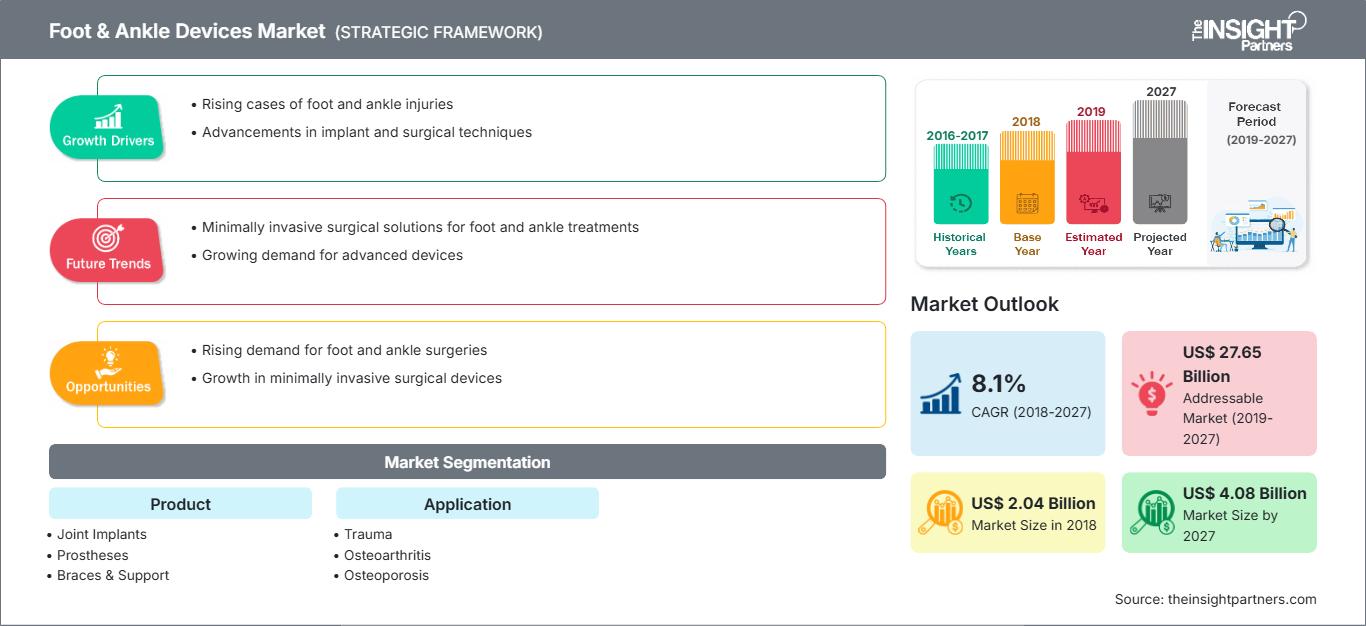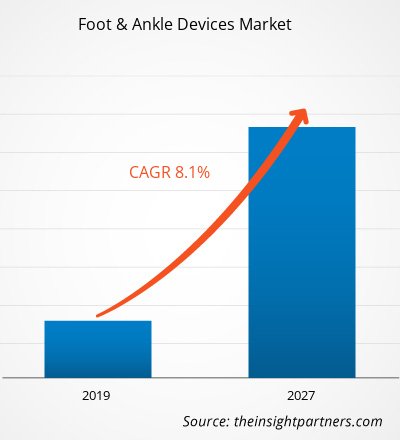[Informe de investigación] El mercado de dispositivos para pie y tobillo se valoró en 2.038,24 millones de dólares estadounidenses en 2018 y se prevé que alcance los 4.084,97 millones de dólares estadounidenses en 2027; se espera que crezca a una tasa de crecimiento anual compuesta (TCAC) del 8,1% entre 2019 y 2027.
Los dispositivos para pie y tobillo se utilizan para tratar lesiones y trastornos en esta zona, con o sin cirugía. Los accidentes y las caídas suelen causar lesiones en pie y tobillo. Por otro lado, la artritis, los juanetes, los dedos en martillo y el pie diabético son algunos de los trastornos que pueden requerir cirugía, seguida del uso de dispositivos para pie y tobillo. El crecimiento del mercado mundial de dispositivos para pie y tobillo se atribuye al aumento de las lesiones deportivas, los accidentes de tráfico y las cirugías ortopédicas. Sin embargo, la falta de reembolso de los procedimientos ortopédicos es el principal factor que limita el crecimiento del mercado.
Se prevé que el mercado mundial de dispositivos para pie y tobillo experimente un crecimiento sustancial tras la pandemia. La COVID-19 ha afectado a las economías e industrias de diversos países debido a los confinamientos, las restricciones de viaje y el cierre de empresas. La crisis de la COVID-19 ha sobrecargado los sistemas de salud pública en muchos países y ha puesto de manifiesto la imperiosa necesidad de una inversión sostenible en dichos sistemas. A medida que avanza la pandemia, se espera que el sector sanitario experimente una desaceleración. El segmento de ciencias de la vida prospera gracias al aumento de la demanda de productos de diagnóstico in vitro y al incremento de las actividades de investigación y desarrollo a nivel mundial. Sin embargo, el segmento de tecnologías médicas e imagen está experimentando una caída en las ventas debido a la menor cantidad de cirugías realizadas y a la demora en la adquisición de equipos. Además, se prevé que las consultas virtuales realizadas por profesionales sanitarios se conviertan en el modelo predominante de prestación de atención médica tras la pandemia. Con la telemedicina transformando la prestación de atención médica, la salud digital seguirá prosperando en los próximos años. Asimismo, se espera que la interrupción de los ensayos clínicos y el consiguiente retraso en el lanzamiento de medicamentos sienten las bases para la realización de ensayos totalmente virtuales en el futuro. Se prevé que nuevas tecnologías como el ARNm surjan y transformen la industria farmacéutica, y también se espera que el mercado experimente una mayor integración vertical y empresas conjuntas en los próximos años.
Obtendrá personalización gratuita de cualquier informe, incluyendo partes de este informe, análisis a nivel de país y paquetes de datos de Excel. Además, podrá aprovechar excelentes ofertas y descuentos para empresas emergentes y universidades.
Mercado de dispositivos para pie y tobillo: Perspectivas estratégicas

-
Obtenga las principales tendencias clave del mercado que se describen en este informe.Esta muestra GRATUITA incluirá análisis de datos, que abarcarán desde tendencias de mercado hasta estimaciones y pronósticos.
Perspectivas del mercado
El aumento del número de cirugías ortopédicas impulsará el crecimiento del mercado mundial de dispositivos para pie y tobillo.
El aumento de las cirugías ortopédicas se debe principalmente al incremento en el número de reemplazos de rodilla y cadera. También se realizan cirugías para amputaciones de extremidades por daños y lesiones causados por accidentes u otras enfermedades. Según la Agencia para la Investigación y la Calidad de la Atención Médica de EE. UU., en ese país se realizan aproximadamente 600 000 reemplazos de rodilla al año.
Las artroplastias de rodilla se realizan en personas mayores para tratar el deterioro de sus articulaciones. Entre las cirugías ortopédicas, las artroplastias de rodilla se encuentran entre las más comunes. El aumento de afecciones como la artritis reumatoide (AR), la espondilitis anquilosante (EA) y la osteoporosis ha conllevado un incremento en el número de cirugías ortopédicas. Por ejemplo, según un informe publicado en 2018 por Healthline Media, la artritis reumatoide (AR) afecta a 41 de cada 100 000 personas al año, y aproximadamente 1,3 millones de estadounidenses padecen AR. Asimismo, datos publicados por la Asociación de Espondilitis de América indican que en Estados Unidos la espondiloartritis afecta a aproximadamente 2,7 millones de personas, lo que representa 1 de cada 100 habitantes. Además, según estimaciones de la Fundación Internacional de Osteoporosis, en 2018 la osteoporosis afectó a casi 200 millones de mujeres en todo el mundo. De las cuales, alrededor de una décima parte de las mujeres tienen más de 60 años, alrededor de una quinta parte de las mujeres tienen 70 años o más, dos quintas partes de las mujeres tienen más de 80 años y dos tercios de las mujeres tienen más de 90 años.
Además, se prevé un aumento en el número de cirugías para tratar trastornos musculoesqueléticos relacionados con el deporte, lesiones laborales y la disfunción asociada a la edad. Por ejemplo, según la Arthritis Foundation, en 2017 se diagnosticaron aproximadamente 54 millones de adultos con artritis. Asimismo, cerca de 300 000 bebés y niños padecen artritis o alguna afección reumática. El tipo de artritis más común es la osteoartritis, que afecta a aproximadamente 31 millones de estadounidenses. Por lo tanto, con el incremento de las cirugías ortopédicas, se anticipa un aumento considerable en la demanda de dispositivos para pie y tobillo. En consecuencia, es probable que el aumento de las cirugías ortopédicas impulse el mercado de dispositivos para pie y tobillo durante el período de pronóstico.
Información basada en el producto
En cuanto a productos, el mercado mundial de dispositivos para pie y tobillo se segmenta en implantes, prótesis, ortesis y soportes, y dispositivos de fijación. En 2018, el segmento de ortesis y soportes representó la mayor cuota de mercado. Sin embargo, se estima que el segmento de implantes registrará la mayor tasa de crecimiento anual compuesto (TCAC) durante el período de pronóstico.
Información basada en aplicaciones
En cuanto a su aplicación, el mercado global de dispositivos para pie y tobillo se segmenta en traumatología, artrosis, osteoporosis, artritis reumatoide y dedo en martillo. En 2018, el segmento de traumatología representó la mayor cuota de mercado. Asimismo, se prevé que este mismo segmento registre la mayor tasa de crecimiento anual compuesto (TCAC) durante el período de pronóstico.
Los actores del mercado mundial de dispositivos para pie y tobillo están adoptando estrategias de lanzamiento y expansión de productos para satisfacer las cambiantes demandas de los clientes en todo el mundo, lo que también les permite mantener su marca a nivel global.
Dispositivos para pie y tobillo
Perspectivas regionales del mercado de dispositivos para pie y tobillo
Los analistas de The Insight Partners han explicado en detalle las tendencias regionales y los factores que influyen en el mercado de dispositivos para pie y tobillo durante el período de previsión. Esta sección también analiza los segmentos y la geografía del mercado de dispositivos para pie y tobillo en Norteamérica, Europa, Asia Pacífico, Oriente Medio y África, y Sudamérica y Centroamérica.
Alcance del informe de mercado de dispositivos para pie y tobillo
| Atributo del informe | Detalles |
|---|---|
| Tamaño del mercado en 2018 | US$ 2.040 millones |
| Tamaño del mercado para 2027 | 4.080 millones de dólares estadounidenses |
| Tasa de crecimiento anual compuesto global (2018 - 2027) | 8,1% |
| Datos históricos | 2016-2017 |
| período de previsión | 2019-2027 |
| Segmentos cubiertos |
Por producto
|
| Regiones y países cubiertos |
América del norte
|
| Líderes del mercado y perfiles de empresas clave |
|
Densidad de los actores del mercado de dispositivos para pie y tobillo: comprensión de su impacto en la dinámica empresarial
El mercado de dispositivos para pie y tobillo está creciendo rápidamente, impulsado por la creciente demanda de los usuarios finales debido a factores como la evolución de las preferencias de los consumidores, los avances tecnológicos y una mayor conciencia de los beneficios del producto. A medida que aumenta la demanda, las empresas amplían su oferta, innovan para satisfacer las necesidades de los consumidores y aprovechan las nuevas tendencias, lo que impulsa aún más el crecimiento del mercado.

- Obtenga una visión general de los principales actores del mercado de dispositivos para pie y tobillo.
Mercado global de dispositivos para pie y tobillo – por producto
- Implantes articulares
- Implantes de tobillo y subtalar
- Implantes falángicos
- Prótesis
- Respuesta dinámica
- Controlado por microprocesador
- Tacón acolchado de tobillo sólido
- Axial simple y multiaxial
- Soportes y ortesis
- Soportes articulados
- Aparatos blandos
- Dispositivos de fijación
- Dispositivos de fijación externa
- Unilateral
- Tobillo con anillo
- Híbrido
- Dispositivos de fijación interna
- Tornillos y clavos
- Platos
Mercado global de dispositivos para pie y tobillo – por aplicación
- Trauma
- Osteoartritis
- Osteoporosis
- Artritis reumatoide (AR)
- Dedo en martillo
Dispositivos para pie y tobillo
- Análisis histórico (2 años), año base, pronóstico (7 años) con CAGR
- Análisis PEST y FODA
- Tamaño del mercado, valor/volumen: global, regional y nacional
- Industria y panorama competitivo
- Conjunto de datos de Excel
Informes recientes
Informes relacionados
Testimonios
Razón para comprar
- Toma de decisiones informada
- Comprensión de la dinámica del mercado
- Análisis competitivo
- Información sobre clientes
- Pronósticos del mercado
- Mitigación de riesgos
- Planificación estratégica
- Justificación de la inversión
- Identificación de mercados emergentes
- Mejora de las estrategias de marketing
- Impulso de la eficiencia operativa
- Alineación con las tendencias regulatorias






















 Obtenga una muestra gratuita para - Mercado de dispositivos para pies y tobillos
Obtenga una muestra gratuita para - Mercado de dispositivos para pies y tobillos